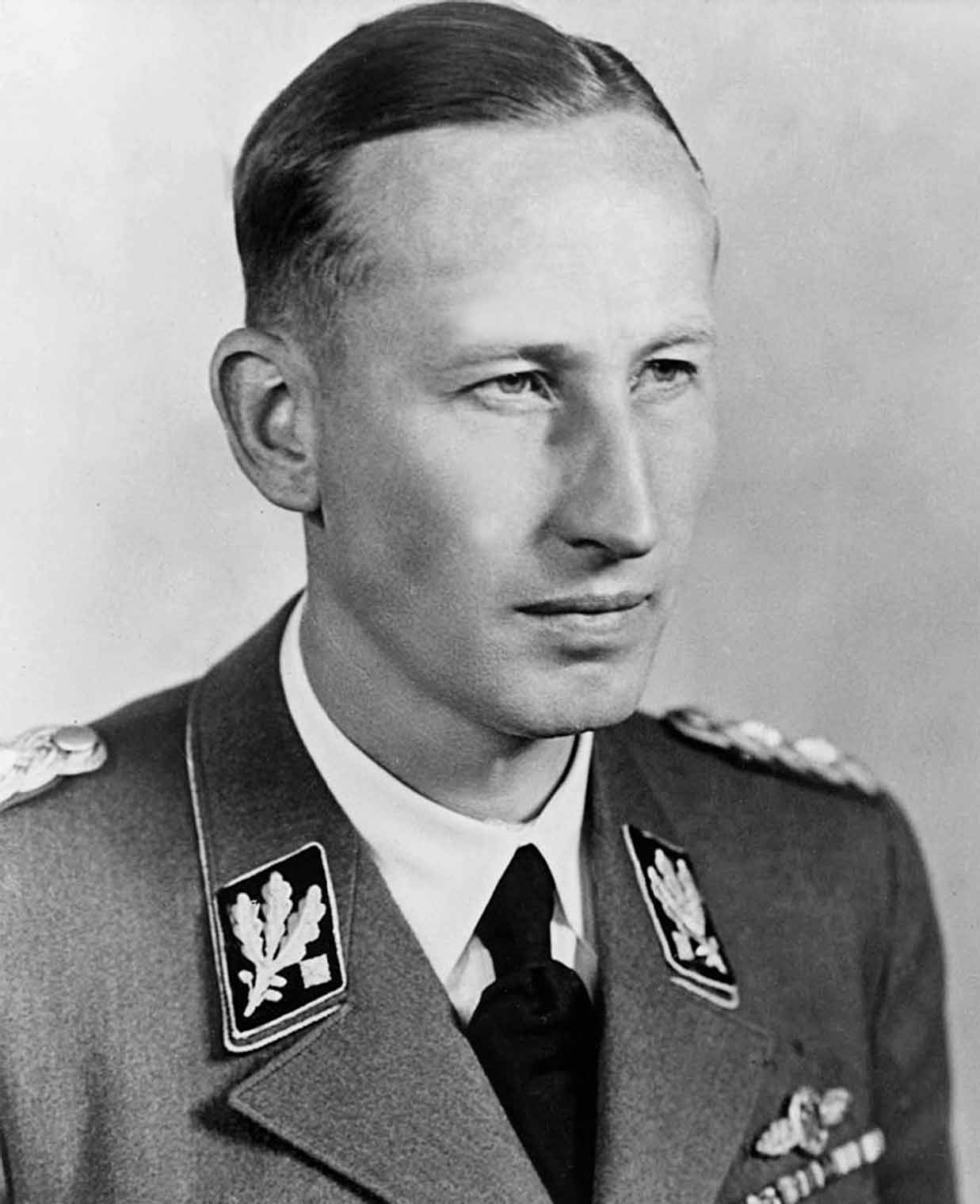
A portrait photo of Reinhard Heydrich, the architect for the murder of the Polish Jews. At the Wannsee conference in January 1942, Heydrich chaired a meeting to discuss ‘the final solution of the Jewish question’.
Initially the German authorities had no clear-cut plan how to deal with what they referred to as the ‘Jewish issue’, other than containing them throughout a vast ghetto system. However, at the Wannsee conference of January 1942, which was a meeting of senior Nazi officials and SS leaders, the ‘final solution of the Jewish question’ was decided upon. The plan was to deport all Jews to occupied Poland and murder them. The Jews in the General Government would be dealt with first.
It was suggested that a series of extermination camps was to be constructed in Poland, to kill Jews quickly and effectively. The codename given for the systematic annihilation of the Polish Jews in the General Government was Operation Reinhard.
There were to be three main camps used for the operation: Bełz˙ec, Treblinka, and Sobibor. But the German authorities were under no illusion of the mammoth task ahead, and more would be needed.
During 1942 the liquidation of the ghettos began in earnest across the General Government. The German Reserve Police Battalion, together with members of the Jewish Police, the Sonderdienst battalion of Ukrainian Trawniki, supported by regular SS soldiers, were ordered to march into the ghettos and round up the Jews. (The Trawniki were Central and Eastern European collaborators recruited from Nazi PoW camps set up for Soviet Red Army soldiers captured in the border regions during the invasion of Russia.)
The Jews were either marched out of the ghetto or loaded on waiting trucks, then they were either transported directly to the camps or would board railway cattle or freight cars to their destination. The liquidation of the ghettos was often violent: the guards would beat and kill Jews in the streets.
The Cze˛stochowa Ghetto, for instance, saw most of its 40,000 inhabitants boarded onto trains under the guise of resettlement, sent directly to Treblinka and murdered. From Miedzyrzec over 10,000 were rounded up by German Order Police battalions and deported to Treblinka. In the Minsk ghetto some 5,000 were forced out of their squalid living places onto freight trains bound for Treblinka.
In some of the ghettos, plans were made to murder the inhabitants in situ. Thousands were killed like this. Around 4,500 from the Izbica Ghetto were marched out of their ghetto and killed in mass pits. The Lida Ghetto saw nearly 6,000 forced out of their ghetto and taken to a nearby military firing range where they were shot in grave pits. In the summer of 1942, the liquidation of the Nowogrόdek ghetto began with the murdering of the Judenra¨te, either by being shot or hung. This was followed with about 1,200 Jews being forced out of the town and marched to the Kurpiasz Forest where they were all shot in hastily prepared pits. On 6 August 1942 between 2,000 and 3,000 Jews were executed in mass graves in the Jewish cemetery on the southern outskirts of Zdzie˛cioł.
The liquidation process was undertaken in phases. At the Konόskowola ghetto, most of the inhabitants were rounded up in the summer of 1942 and transported to the Sobibor extermination camp, but it was not until October 1942 that the last of the ghetto would be liquidated. The final 800 to 1,000, many of them women and children, were taken to a nearby forest and massacred by Reserve Police Battalion 101. At the Buczacz ghetto in the summer of 1942 some 4,500 Jews were either murdered or transported to Bełz˙ec. However, it would not be until early April 1943 that more than 2,000 Jews regarded as ‘unskilled labour’ were removed from the ghetto and murdered in pits near Fedor Hill. Shortly after that, more inmates of the ghetto were removed and sent to the Podheitzka labour camp. In April and May 1943, an additional 3,000 Jews were murdered. By June 1943, the last of the ghetto was liquidated with the remaining Jews deported or shot. In the Krakόw ghetto, due to its size, the liquidation was done in phases. The first transport consisted of 7,000, the second 4,000, all deported to Bełz˙ec in the summer of 1942. It was not until March 1943 that the final liquidation was carried out. Those deemed unfit for labour, around 2,000, were rounded up and either murdered in the streets of the ghetto or transported to Auschwitz. The 8,000 that were left were transported and forced to work in the Płaszόw labour camp.
The clearing of the Warsaw ghetto (the largest ghetto in occupied Europe with some 460,000 Jews contained within its walls) was an immense undertaking. The responsibility for the shipments from Warsaw in liaison with the railway authorities of the Ostbahn was put in the hands of SS-Hauptsturmfu¨hrer Hermann Ho¨ fle. The first phase of the operation was set in motion on 22 July 1942 – the Treblinka death camp railway station received a telegram saying that cattle trains would start travelling between Warsaw and Treblinka. It confirmed that the trains would have sixty closed cars each and that they would be transporting deportees from the Warsaw ghetto. At Treblinka camp they would be unloaded and then sent back empty. All the inhabitants from the ghetto were destined for the new death camp, code-named TII.
Ho¨ fle issued the following order to the Jewish Council in Warsaw:
The Jewish Council is hereby informed of the following:
1.All Jewish persons irrespective of age or sex who live in Warsaw will be resettled in the east.
2.The following are excluded from the resettlement:
(a)All Jewish persons who are employed by the German authorities or by German agencies and can provide proof of it.
(b)All Jewish persons who belong to the Jewish Council and are employees of the Jewish Council.
(c)All Jewish persons who are employed by German firms and can provide proof of it.
(d)All Jews capable of work who have not hitherto been employed. They are to be placed in barracks in the ghetto.
(e)All Jewish persons who are members of the personnel of the Jewish hospitals. Similarly, the members of the Jewish disinfection troops.
(f)All Jewish persons who belong to the Jewish police force.
(g)All Jewish persons who are close relatives of the persons referred to in (a)–(f). Such relatives are restricted to wives and children.
(h)All Jewish persons who on the first day of the resettlement are in one of the Jewish hospitals and are not capable of being released. The fitness for release will be decided by a doctor to be designated by the Jewish Council.
2. Every Jewish person being resettled may take 15kg of his property as personal luggage. All valuables may be taken: gold, jewellery, cash etc. Food for three days should be taken.
4. The resettlement begins on 22 July 1942 at 11 o’clock.
II. The Jewish Council is responsible for providing the daily quota of Jews for transportation. To carry out this task the Jewish council will use the Jewish police force (100 men). The Jewish Council will ensure that every day from 22 July onwards, by 16.00 at the latest, 6,000 Jews will be assembled directly on the loading platform near the transfer office. To start with, the Jewish Council may take the quotas of Jews from the whole population. Later, the Jewish Council will receive special instructions according to which particular streets and blocks of flats are to be cleared.
VIII. Punishments:
(a)Any Jewish person who leaves the ghetto at the start of the resettlement without belonging to the categories of persons outlined in 2(a) and (c), and in so far as they were not hitherto entitled to do so, will be shot.
(b)Any Jewish person who undertakes an act which is calculated to evade or disturb the resettlement measures will be shot.
(c)Any Jewish person who assists in an act calculated to evade or disturb the resettlement measures will be shot.
(d)All Jews who, on completion of the resettlement are encountered in Warsaw and do not belong to the categories referred to in 2(a)-(h), will be shot.
The Jewish council is hereby informed that, in the event that the orders and instructions are not carried out 100%, an appropriate number of the hostages who have been taken in the meantime will be shot.
The liquidation of the Warsaw ghetto was a massive deportation action in which 265,000 ghetto residents were sent to the Treblinka extermination camp and some 20,000 to labour camps. This process took twelve weeks to achieve and it soon became apparent to the Jews left inside the ghetto that these were deportations to death camps. What followed was a ghetto uprising in April 1943.
Uprisings had not been uncommon during the liquidation process of the ghettos, and the German authorities fought back, with harsh consequences for both perpetrators and the innocent. However the most famous was that in the Warsaw ghetto. This uprising raged for three and a half weeks and was contested fiercely by 2,000 Waffen-SS troops. It was a bloodbath on both sides and the ghetto was razed to the ground.

A portrait photo of Reinhard Heydrich, the architect for the murder of the Polish Jews. At the Wannsee conference in January 1942, Heydrich chaired a meeting to discuss ‘the final solution of the Jewish question’.
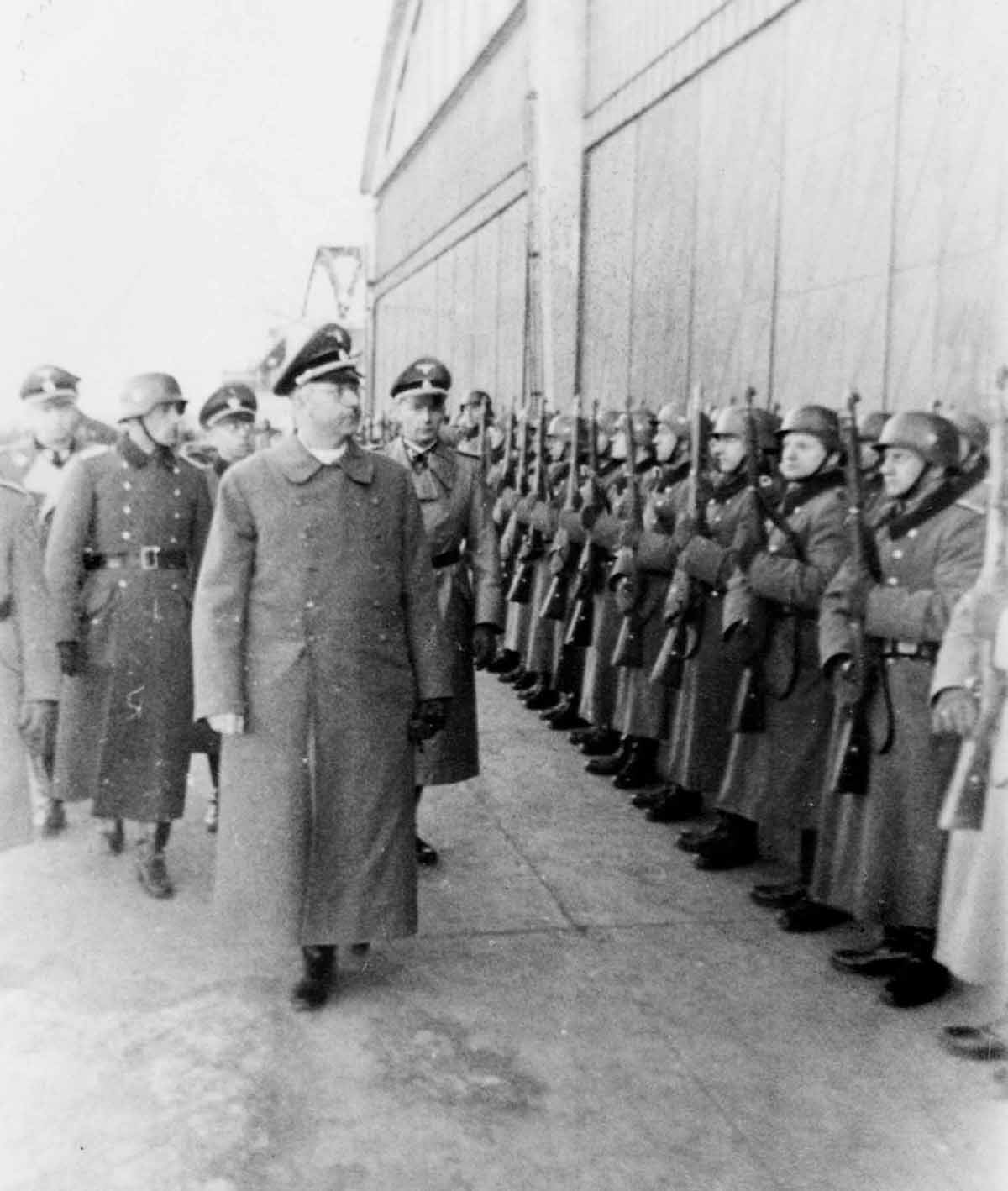
Reichsfu¨ hrer-SS Heinrich Himmler reviews a unit of SS-police in Krakόw in the company of Friedrich-Wilhelm Krueger on 13 March 1942. Later that evening, Himmler met with General Governor Hans Frank. At that meeting, Himmler communicated the message that by the end of 1942 half of all the Jews in the General Government would be murdered. (USHMM: James Blevins)
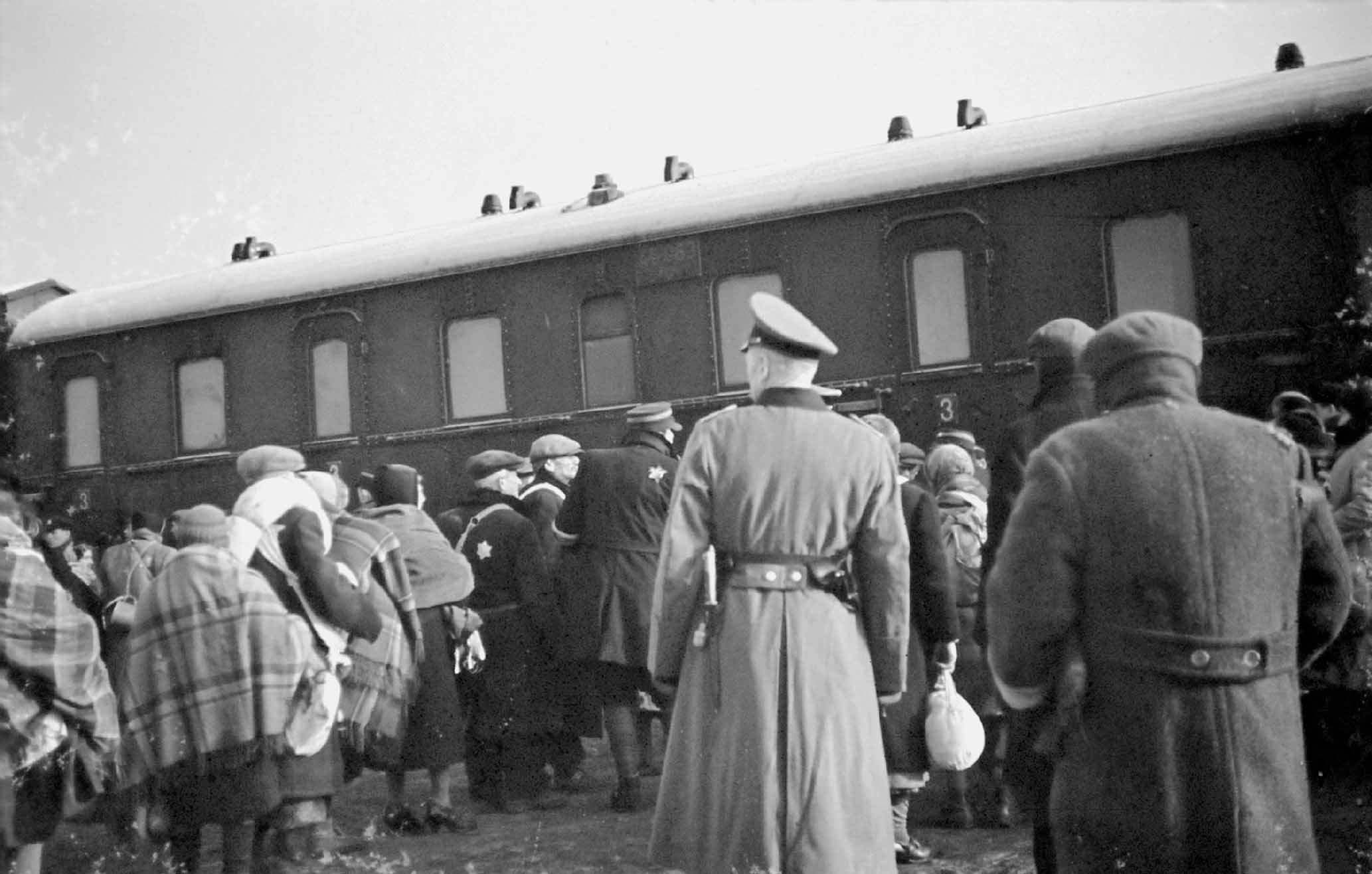
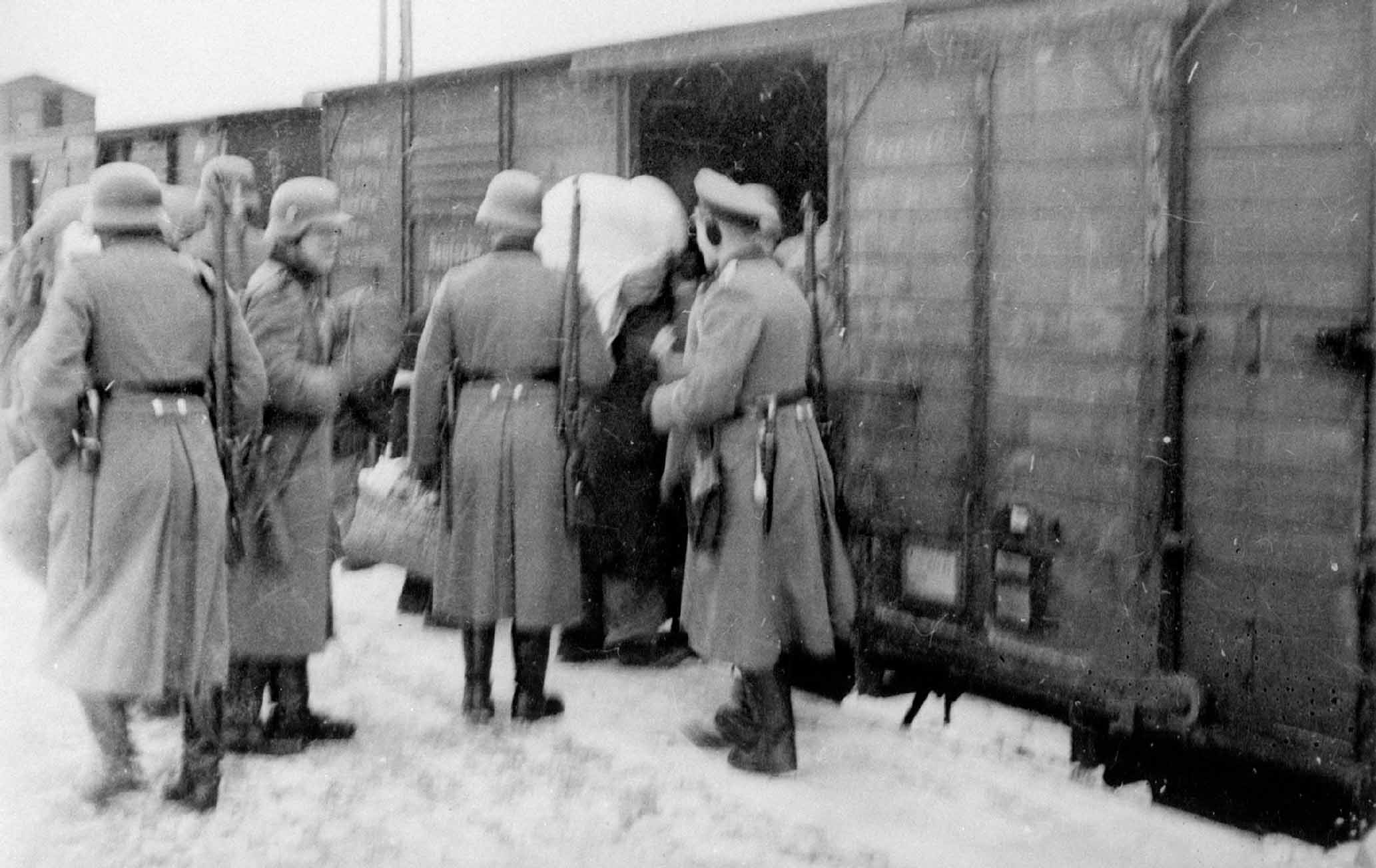
Two photographs show German soldiers overseeing Jews from the Zyrardow ghetto boarding a deportation train. (USHMM: Instytut Pamieci Narodowej)
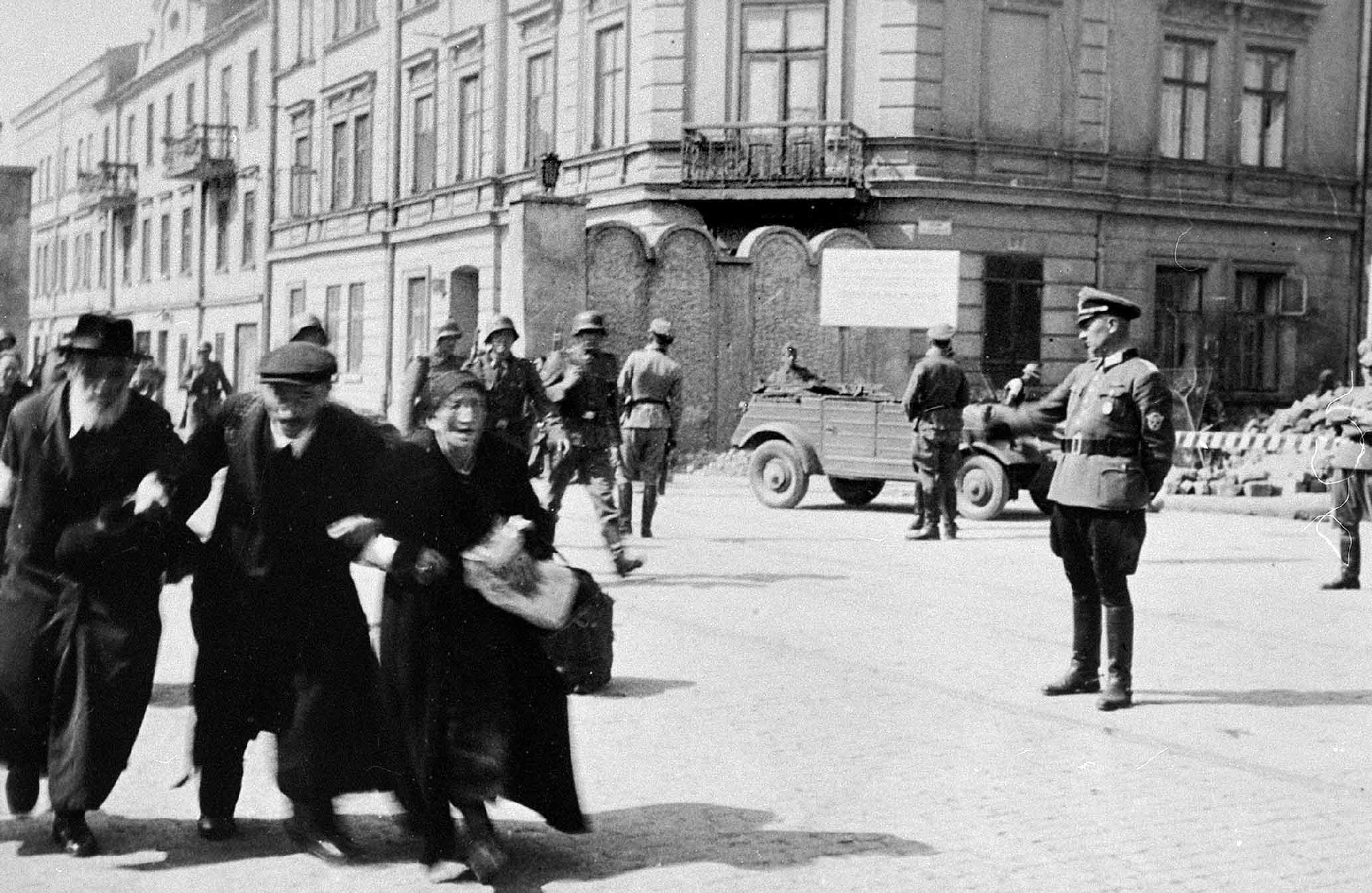
Three elderly Jews walk arm-in-arm through the streets of Krakόw during the final liquidation of the ghetto in March 1943. (USHMM: Instytut Pamieci Narodowej)
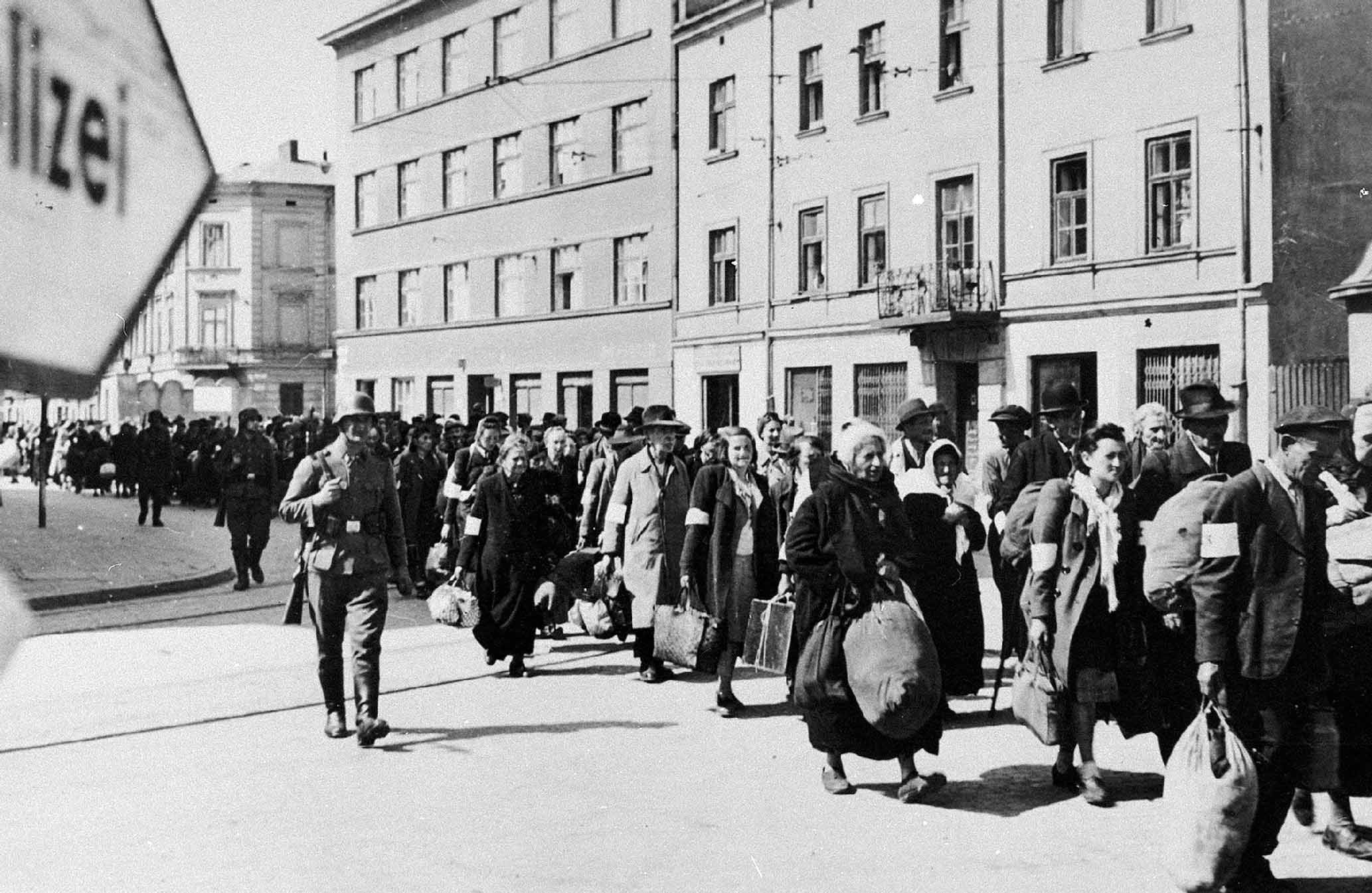
A column of Jews march with bundles down a main street in Krakόw during the liquidation of the ghetto. SS guards oversee the deportation. (USHMM: Instytut Pamieci Narodowej)
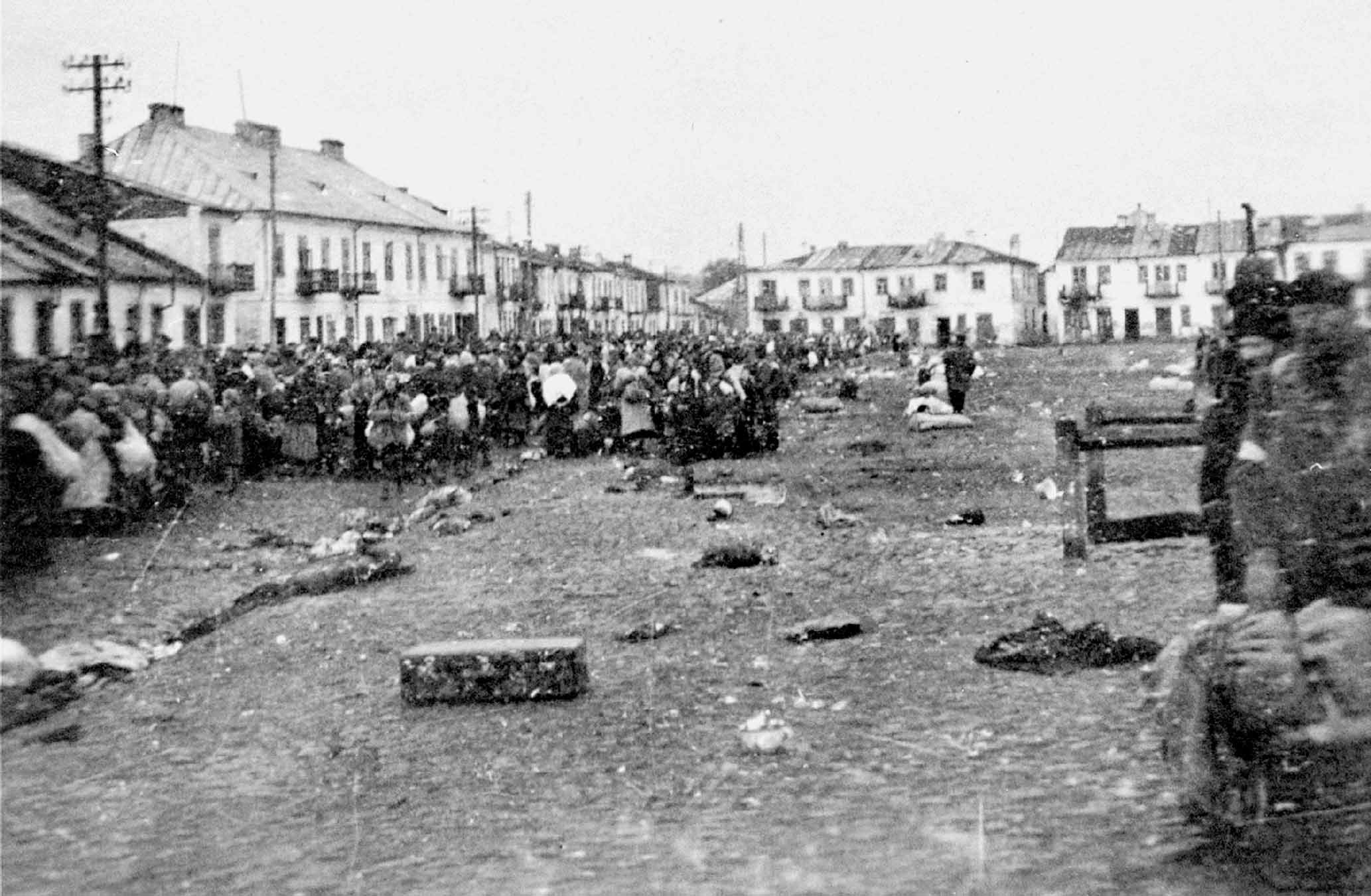
Jews are rounded up for deportation in the Wisznice ghetto. (USHMM: Eliezer & Jenelly Rosenberg)
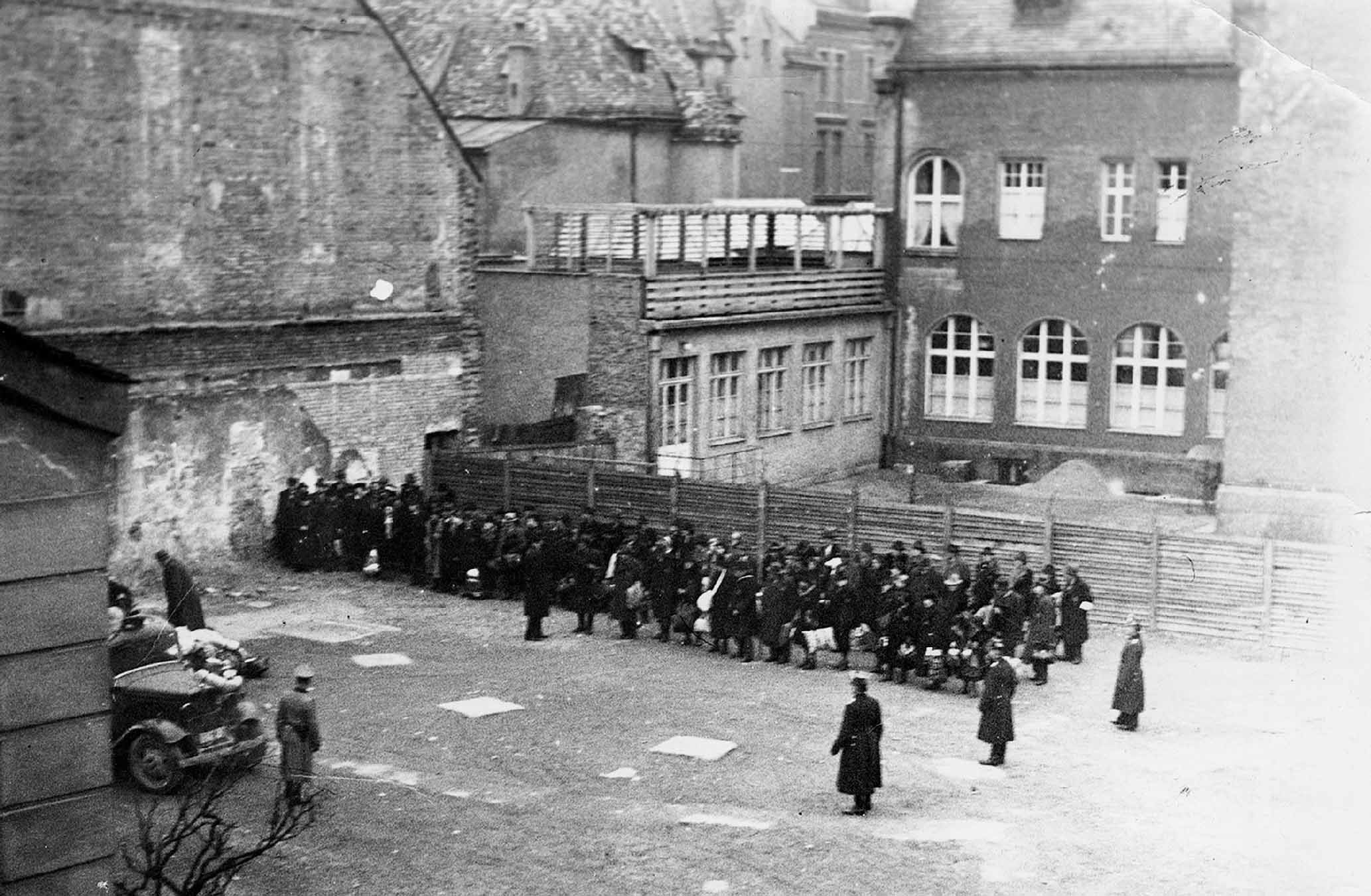
German soldiers are seen rounding up Jews on Francuska Street in the Dombrowa ghetto. (USHMM: Sidney Schlesinger)
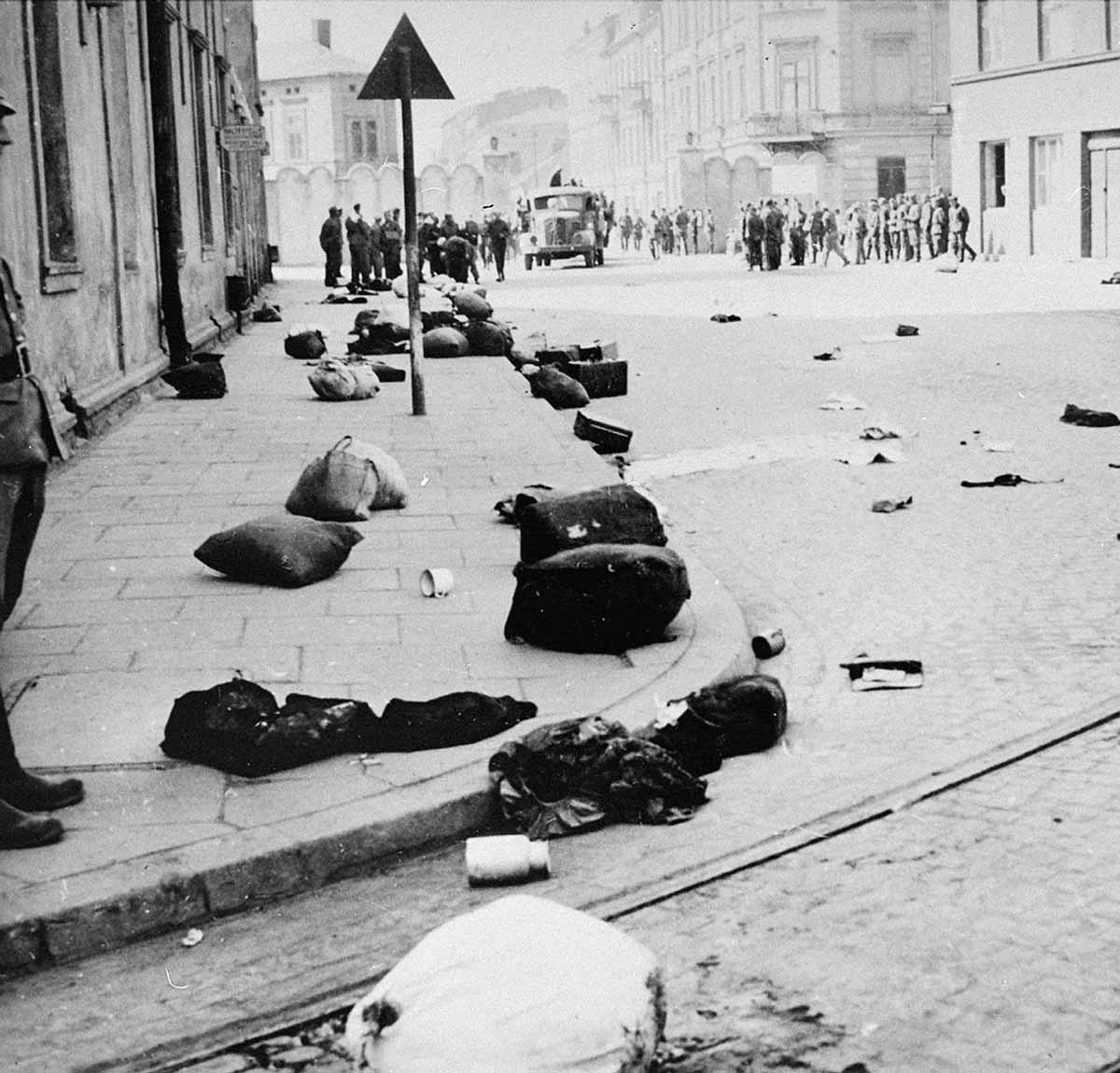
View of a major street in Krakόw following the liquidation of the ghetto. Strewn across the street are bundles of possessions left behind by the Jews who were hurriedly removed from the ghetto in March 1943. (USHMM: Instytut Pamieci Narodowej)
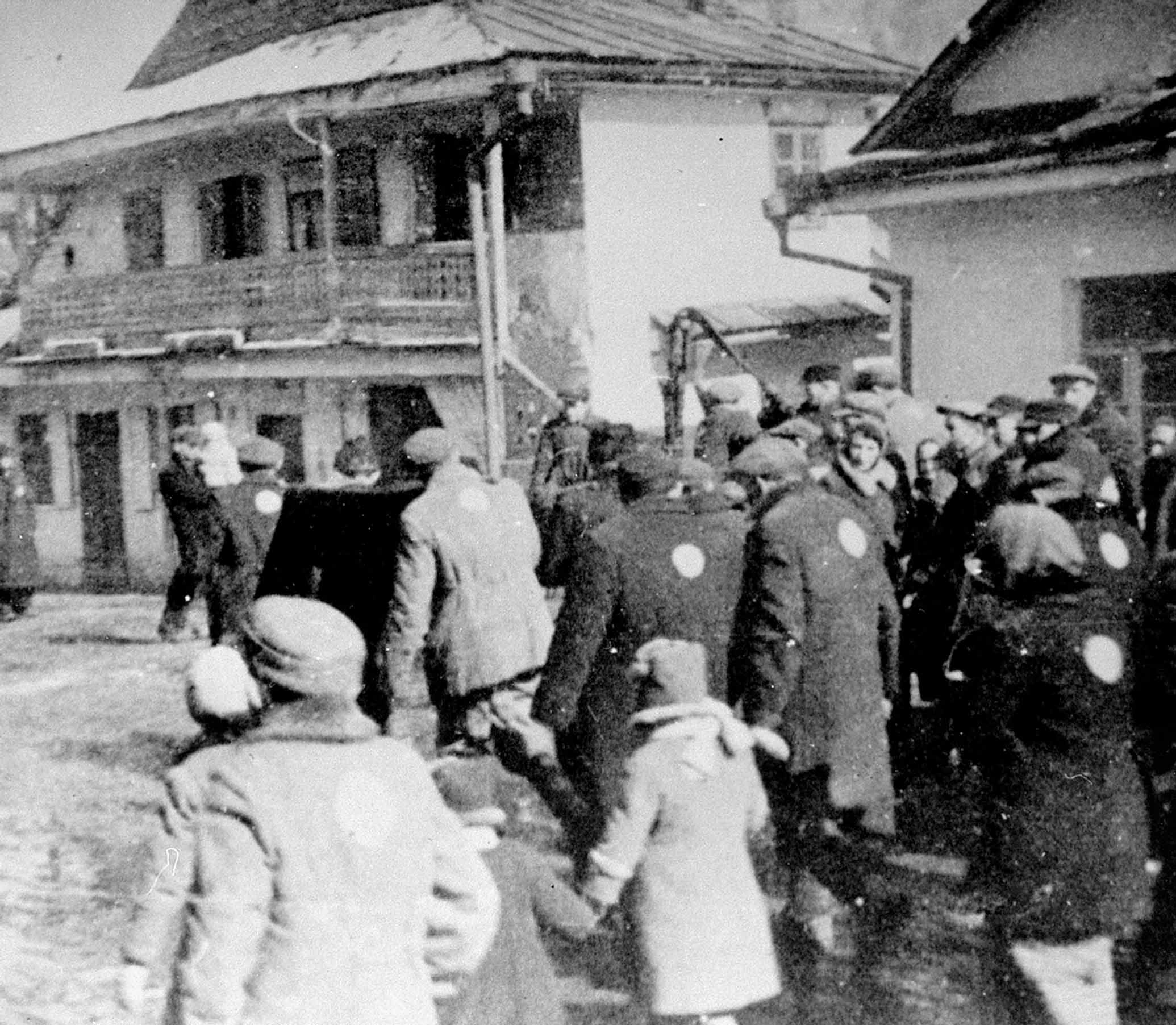
Jews wearing circular badges walk through town during a deportation action from the Krzemieniec ghetto. During the liquidation of the ghetto on 22 July 1942, there was armed resistance by the Jews against the Germans. But the resistance was short-lived and the surviving inhabitants were rounded up and deported. Some 19,000 were killed in this action. (USHMM: Instytut Pamieci Narodowej)
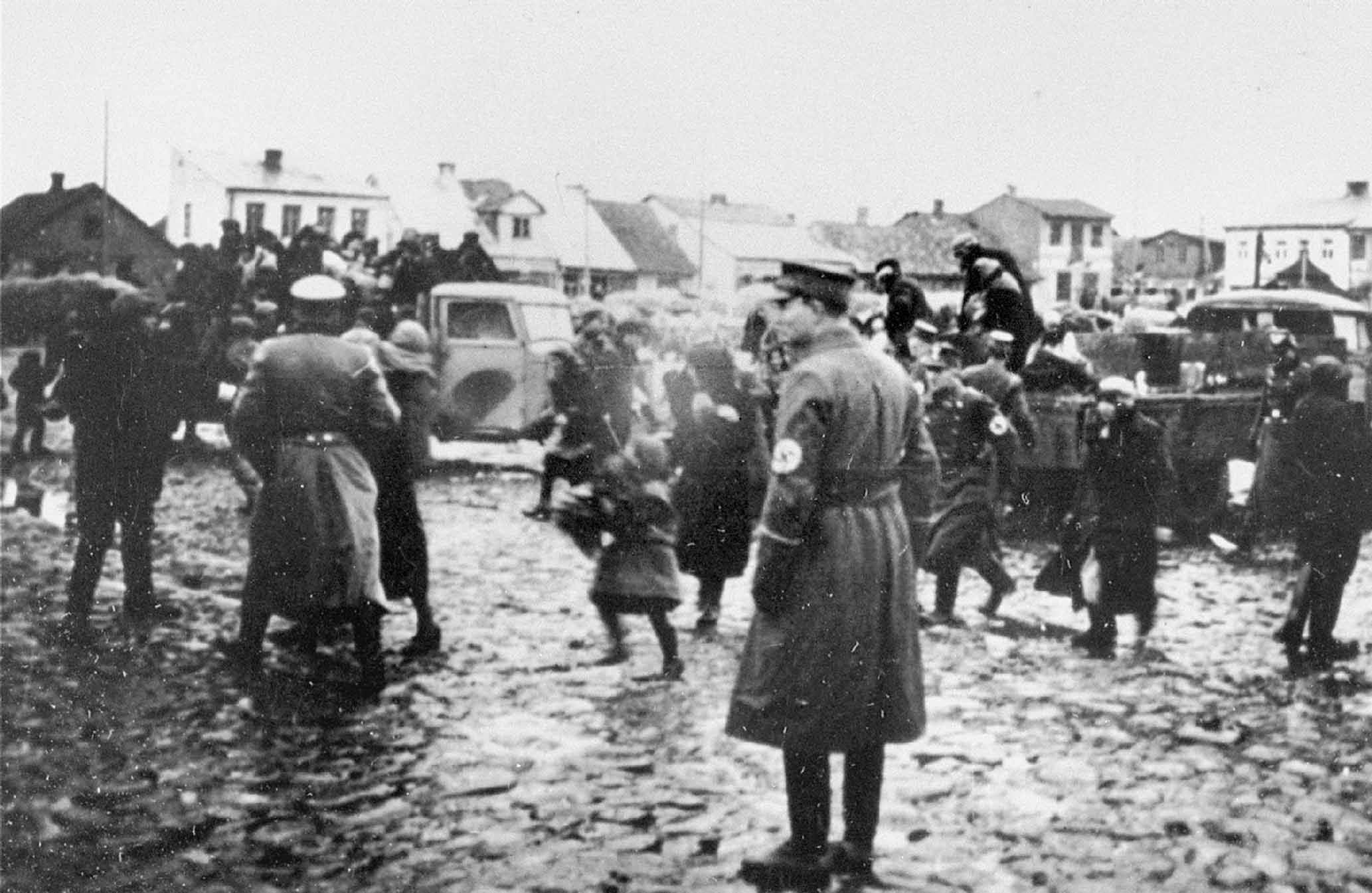
German police round up Jews and load them onto trucks in the Ciechanow ghetto during the liquidation. (USHMM: Instytut Pamieci Narodowej)
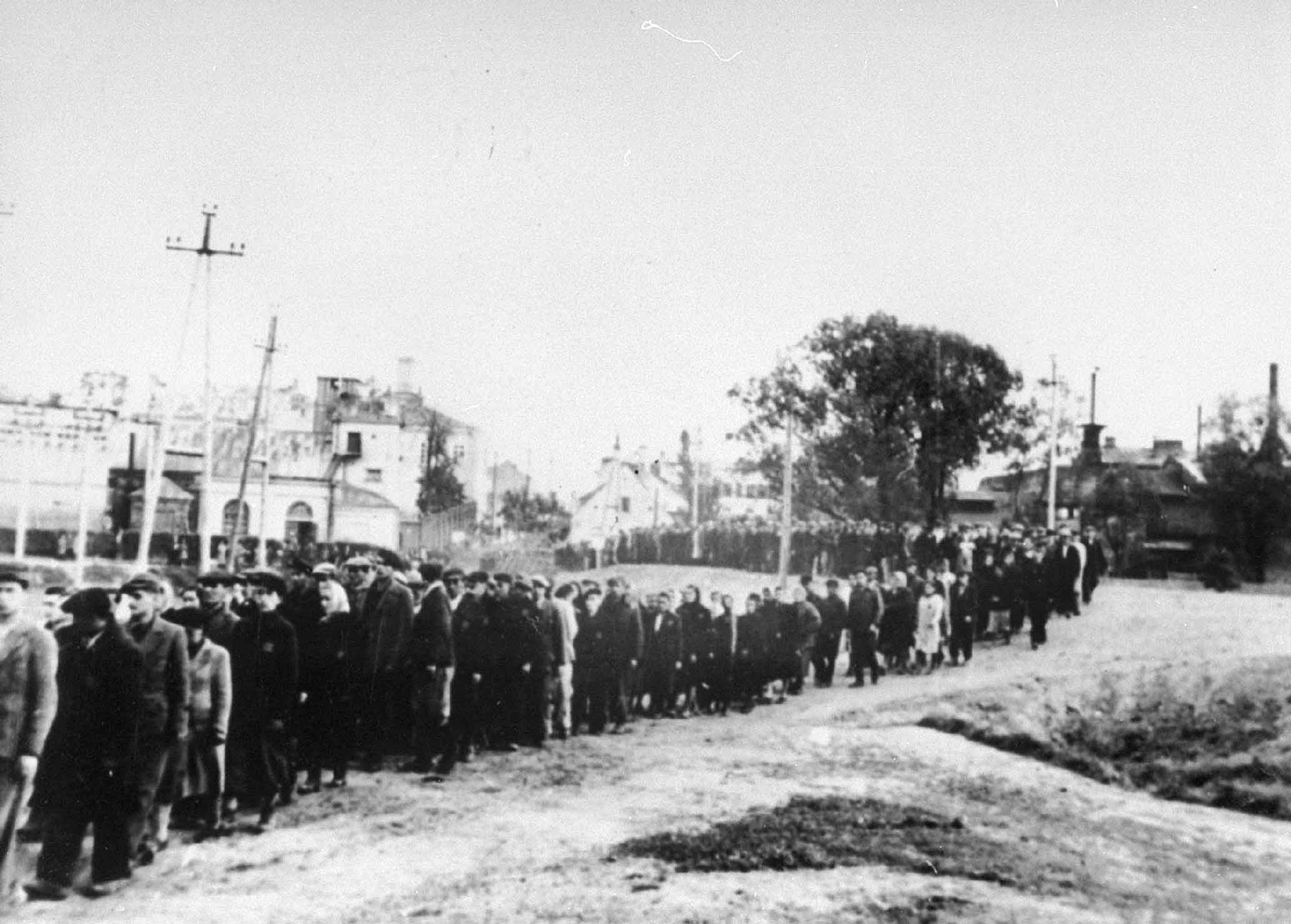
Jews from the Ciechanow ghetto are marched out of town to a fortress to be contained there before the ghetto is liquidated. Most of the Jews in this photograph were eventually transported to the Red Forest north-east of the town and murdered by gunfire. (USHMM: Instytut Pamieci Narodowej)
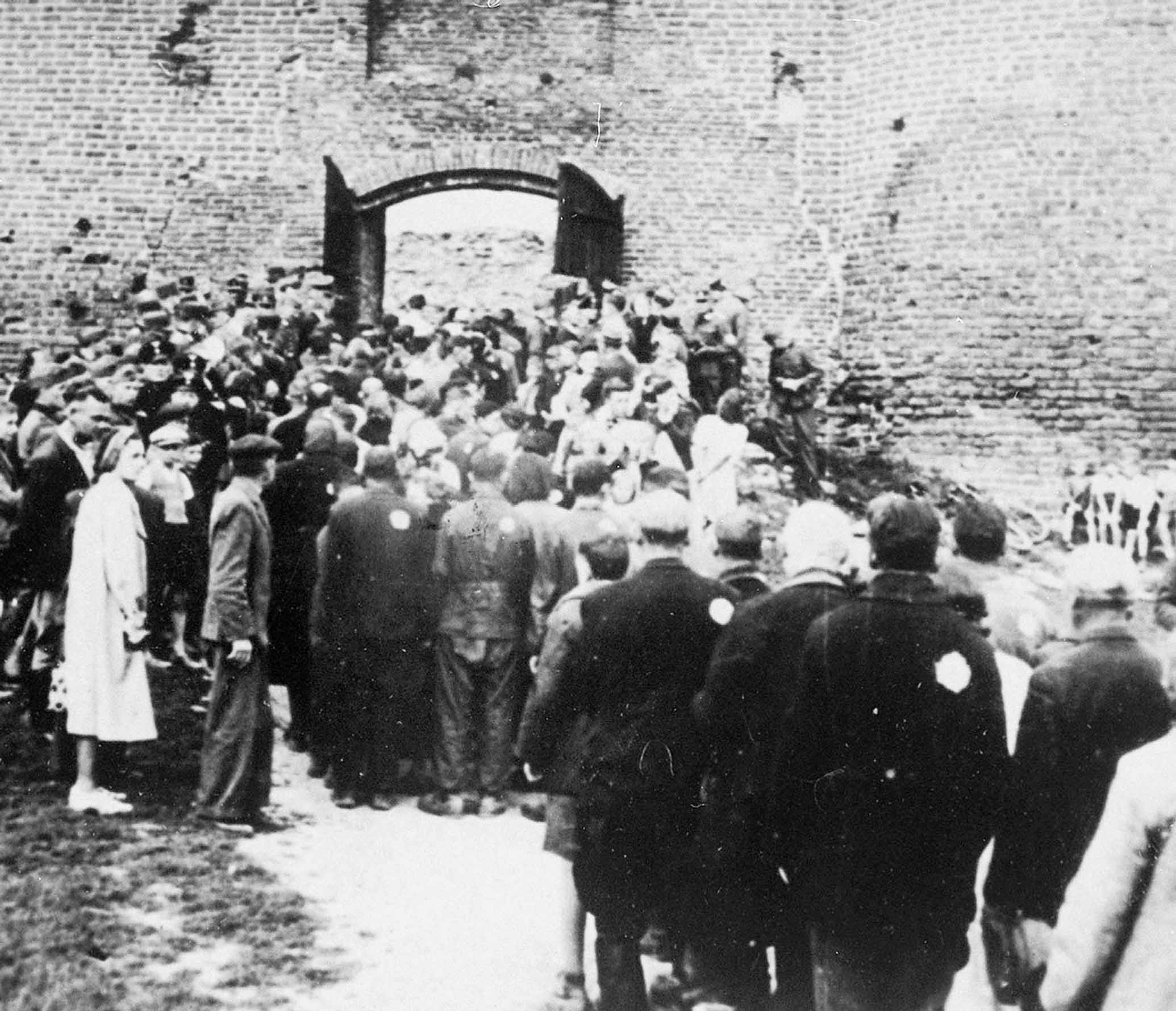
Jews from the Ciechanow ghetto are assembled in a fortress. During the war many Polish Jews and resistance fighters were executed by the Germans in the castle. (USHMM: Instytut Pamieci Narodowej)
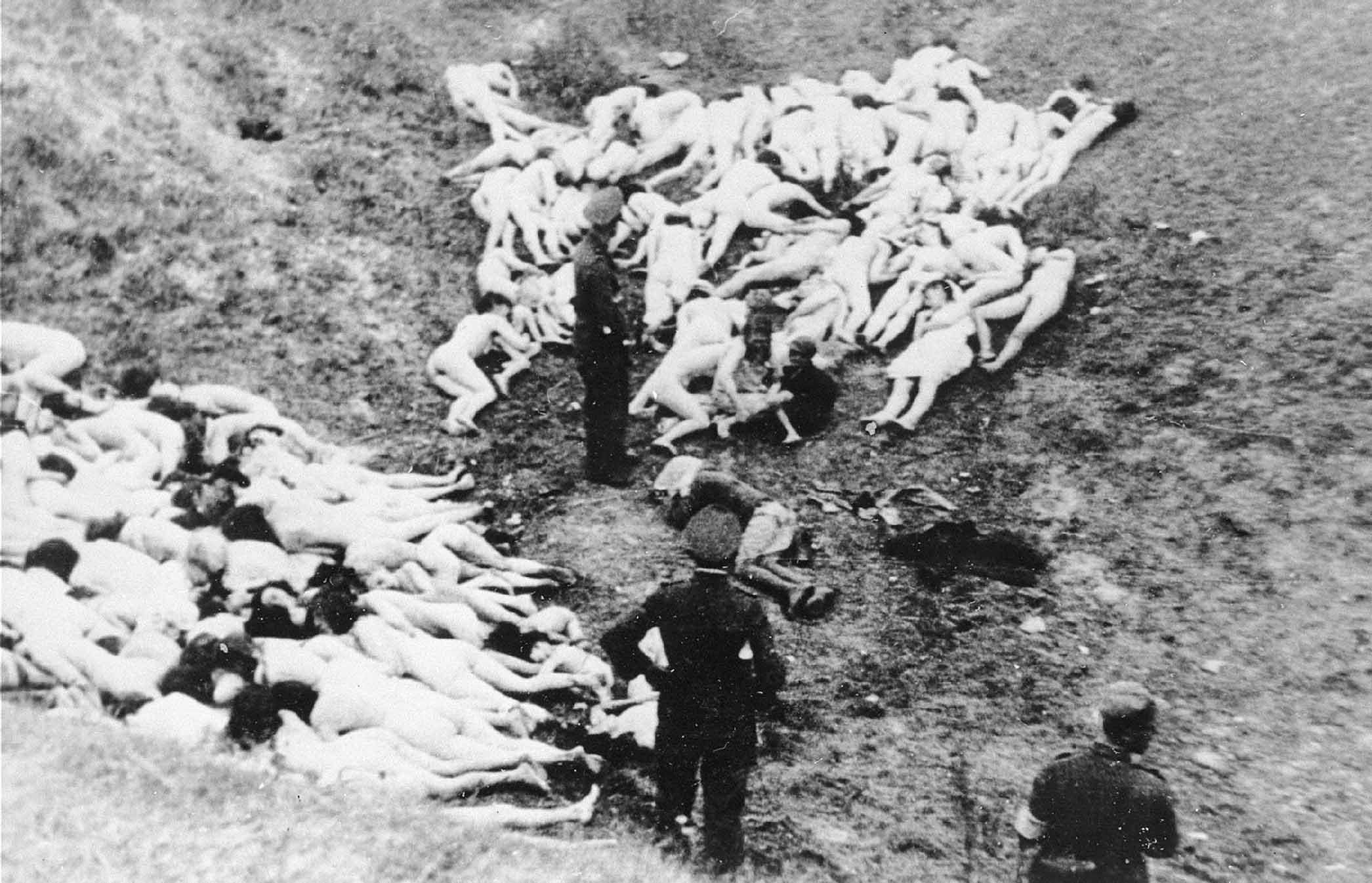
A German policeman prepares to complete a mass execution of the remaining inhabitants of the Mizocz ghetto by shooting two Jewish children, who can still be seen sitting up looking very distressed. The Mizocz Ghetto had initially held some 1,700 Jews. On 13 October 1942, the eve of the ghetto’s liquidation, some of the inhabitants rose up against the Germans and were defeated after a short battle. The remaining members of the community were transported from the ghetto to a ravine in the Sdolbunov, south of Rovno. At the edge of the ravine the Jews, mainly women and children, were ordered to undress, herded down the ravine, and then shot. (USHMM: Instytut Pamieci Narodowej)
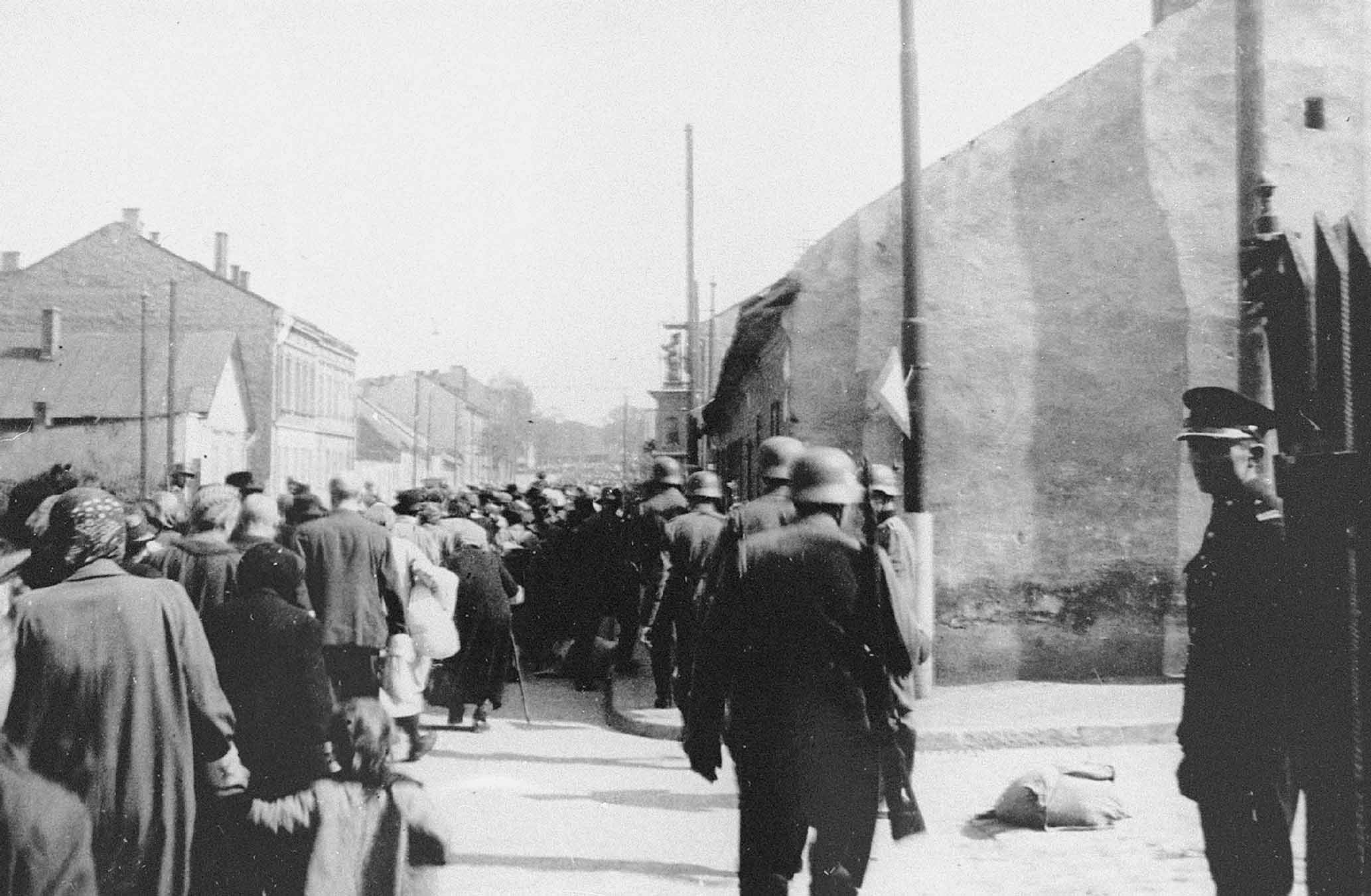
A column of Jews marches through the streets of Krakόw during the final liquidation of the ghetto. (USHMM: Instytut Pamieci Narodowej)
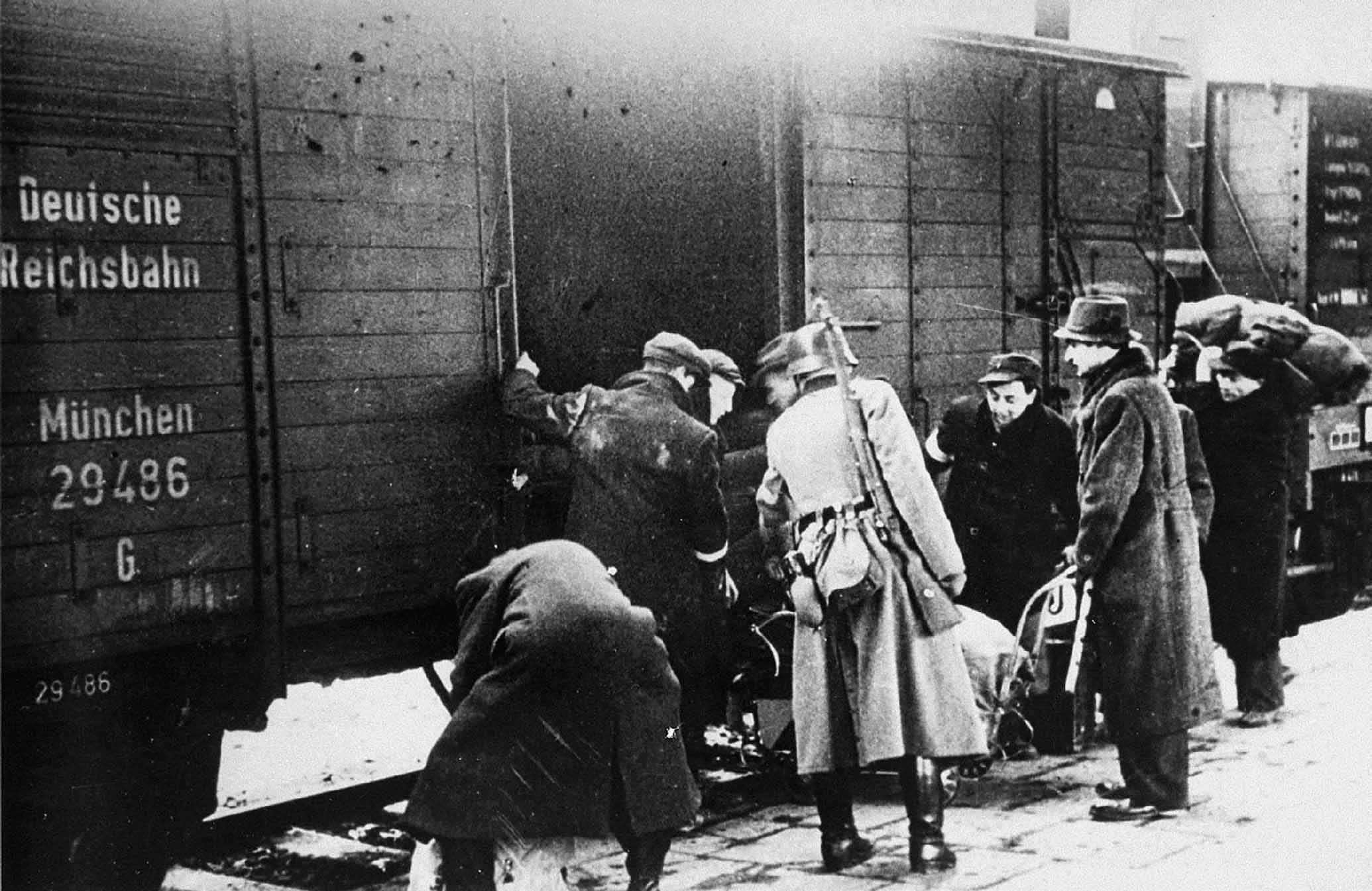
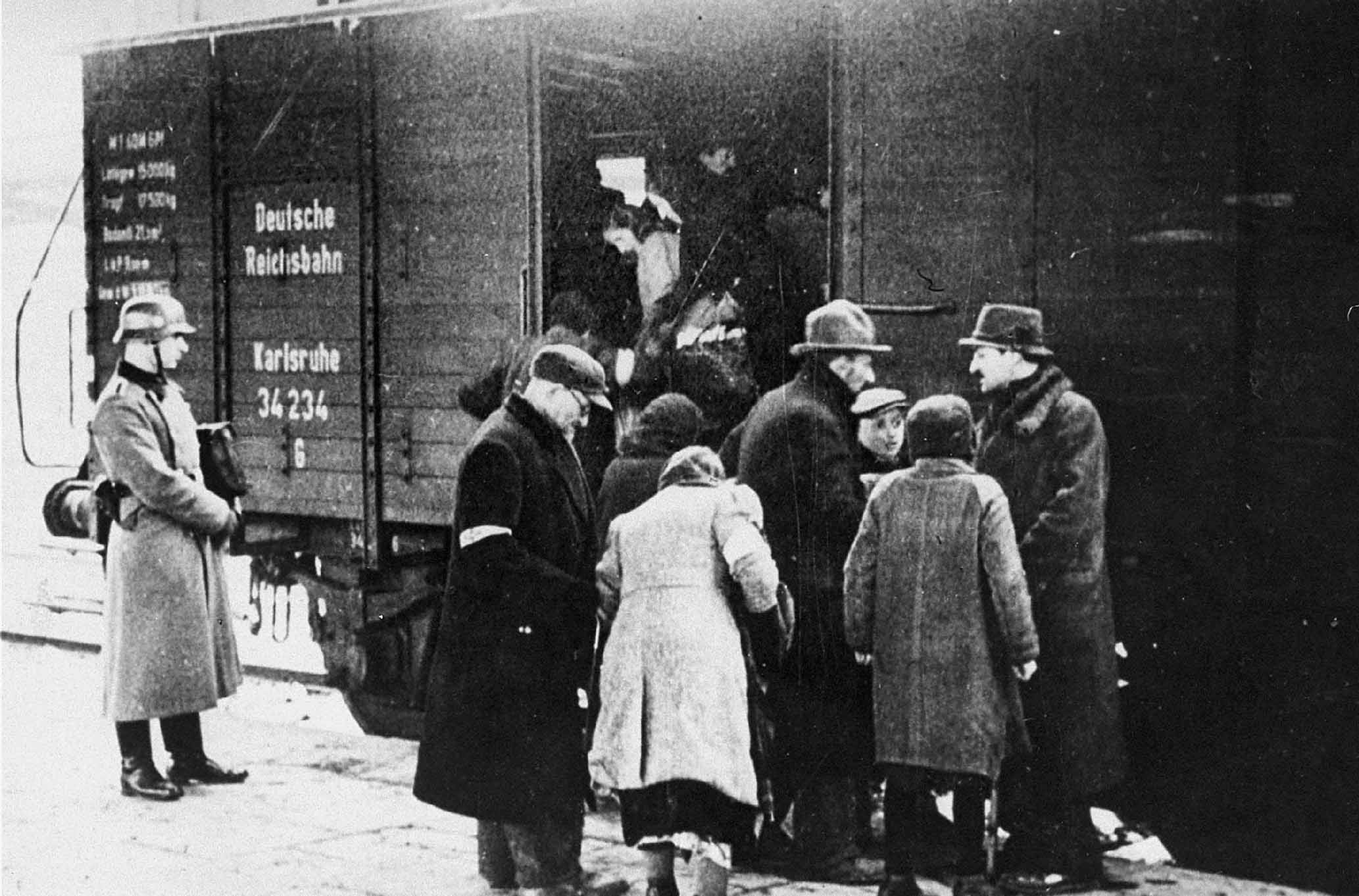
Two photographs showing SS soldiers supervising the boarding of Jews onto trains during a deportation action in the Krakόw ghetto in March 1943. (USHMM: Archiwum Dokumentacji Mechanicznej)
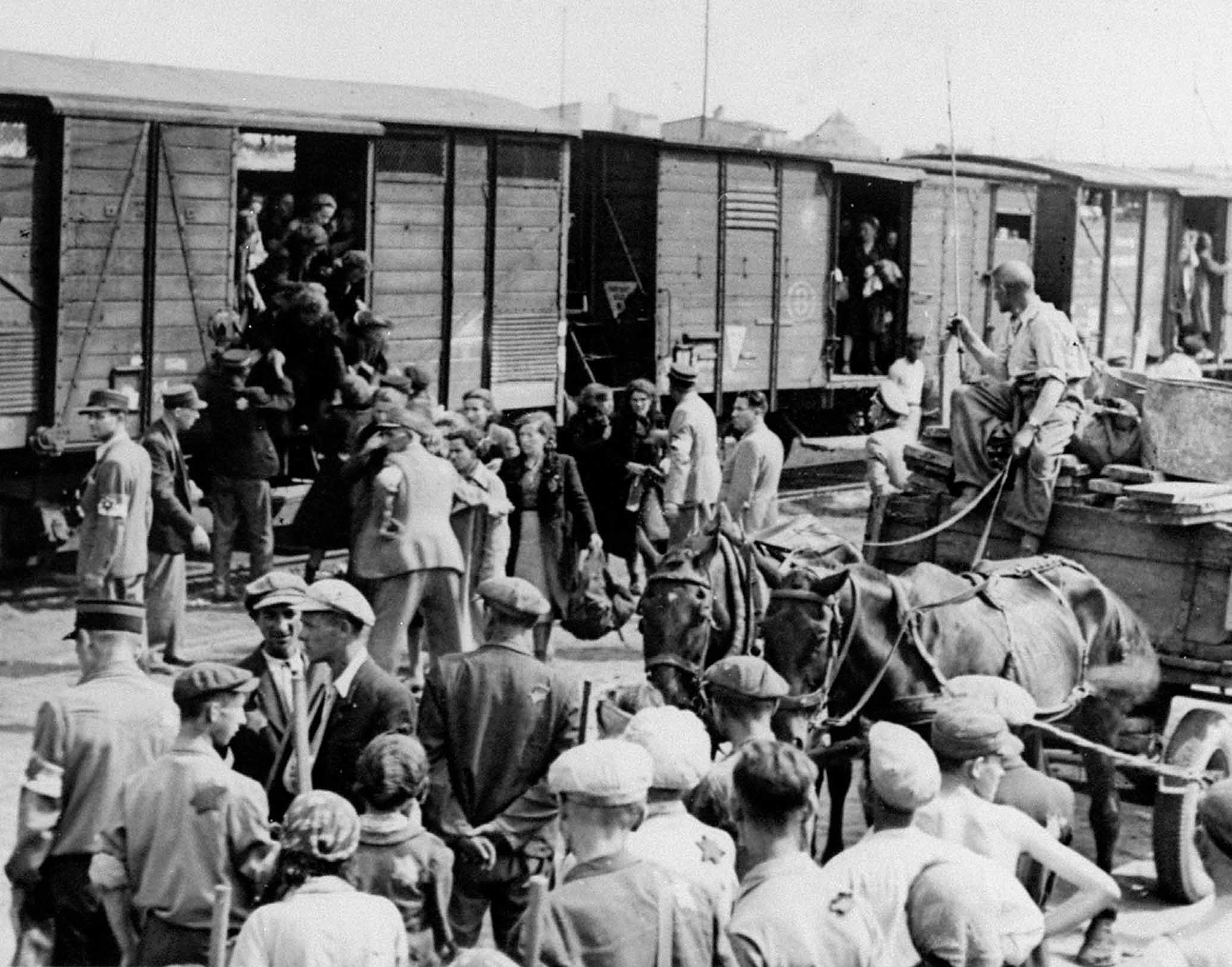
Jews from the Łódź ghetto board deportation trains to the Chełmno death camp. Some 55,000 Jews were sent to Chełmno between January and May 1942. Four months later a further 15,000 were deported in a second phase of the liquidation of the ghetto. They were all sent directly to Chełmno. There were no further deportations to death camps from Łódź for the next one and a half years, but from 23 June to 15 July 1944 some 7,000 Jews were deported to Chełmno. Thereafter, all deportation trains were routed to Auschwitz. The transports to Auschwitz commenced on 7 August and continued until 30 August, by which time more than 74,000 Jews had been sent to their deaths there. After this final transport, 1,200 Jews remained in two assembly camps in Łódź. Roughly half of them were soon transferred to labour camps in Germany.
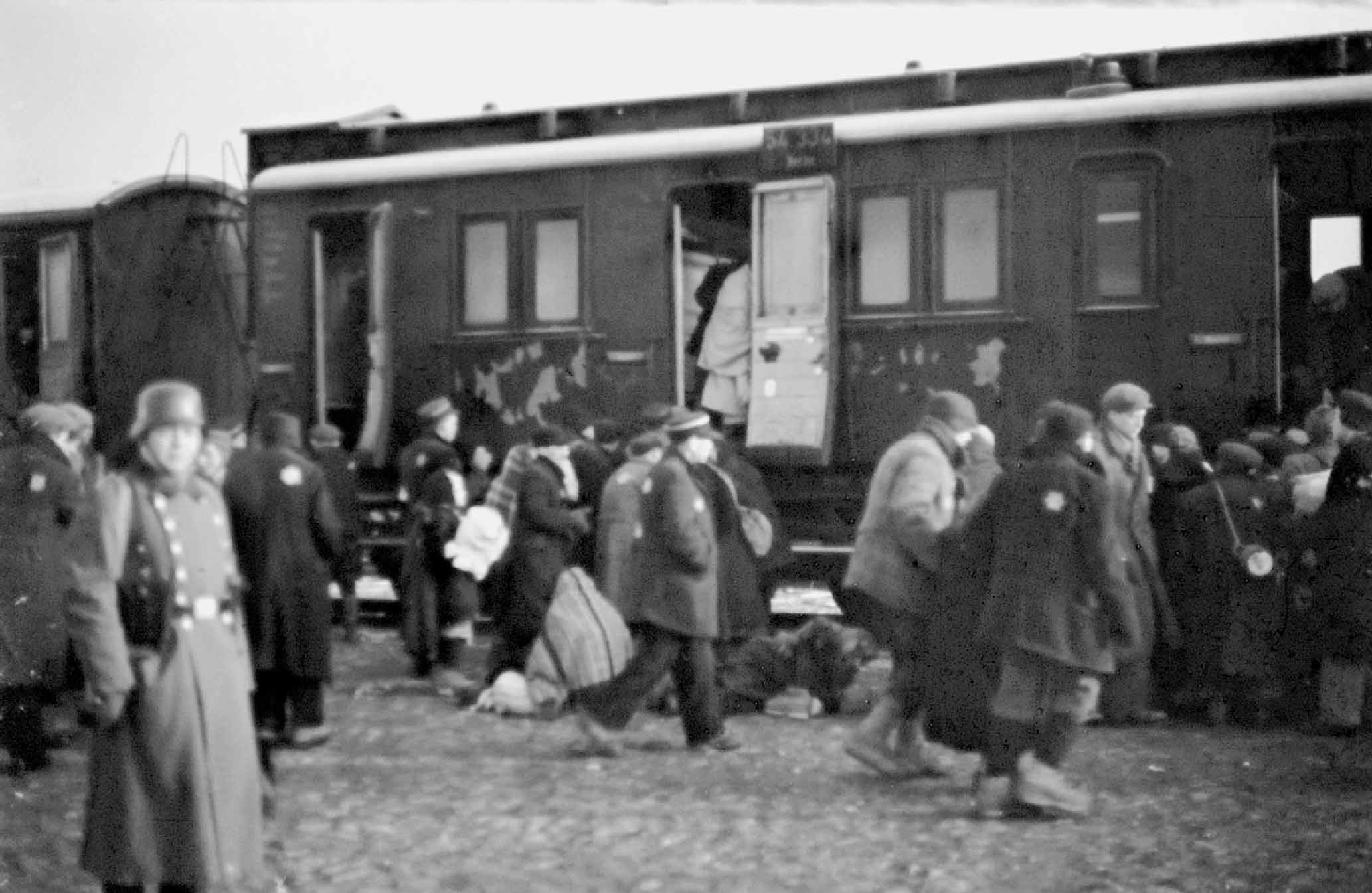
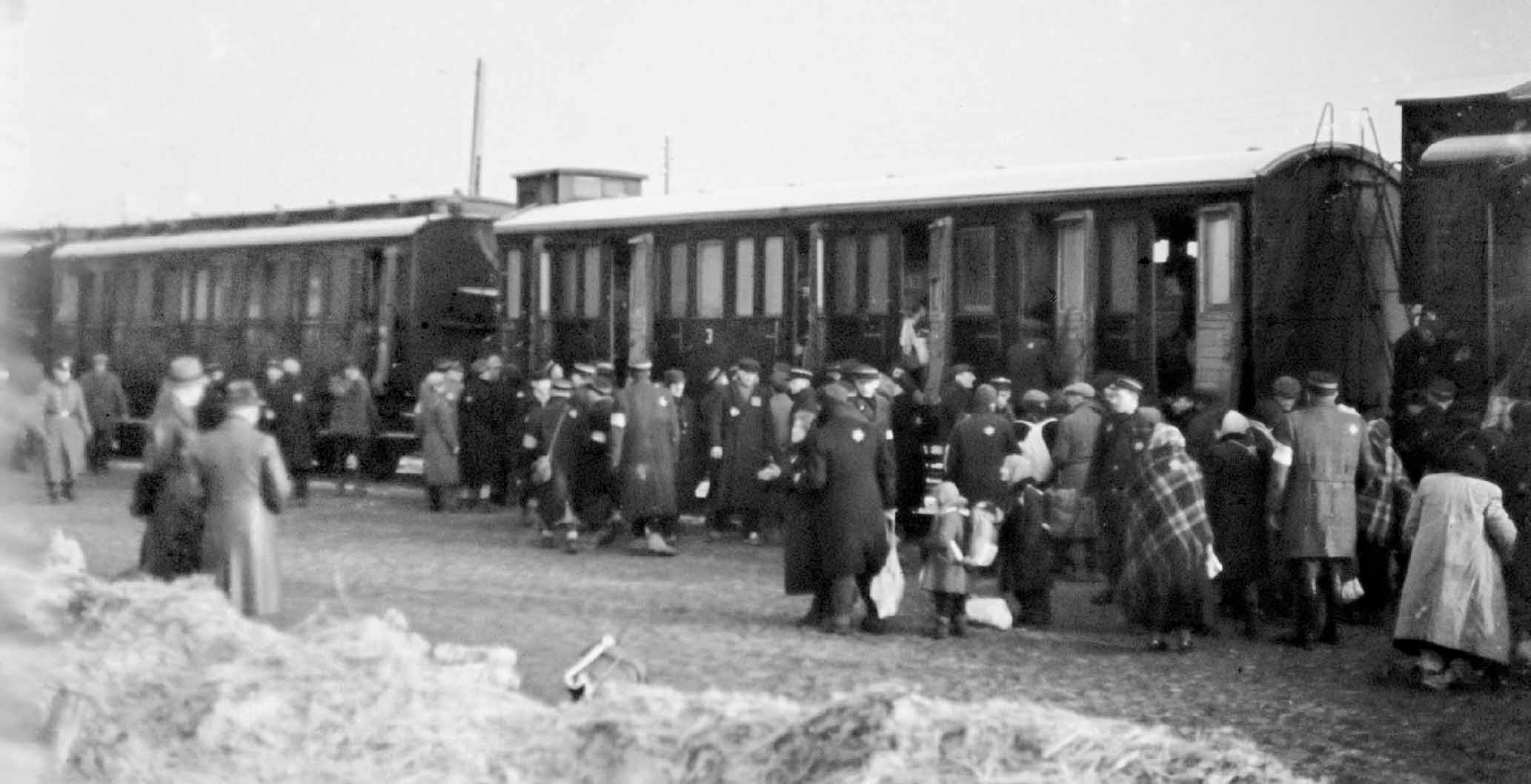
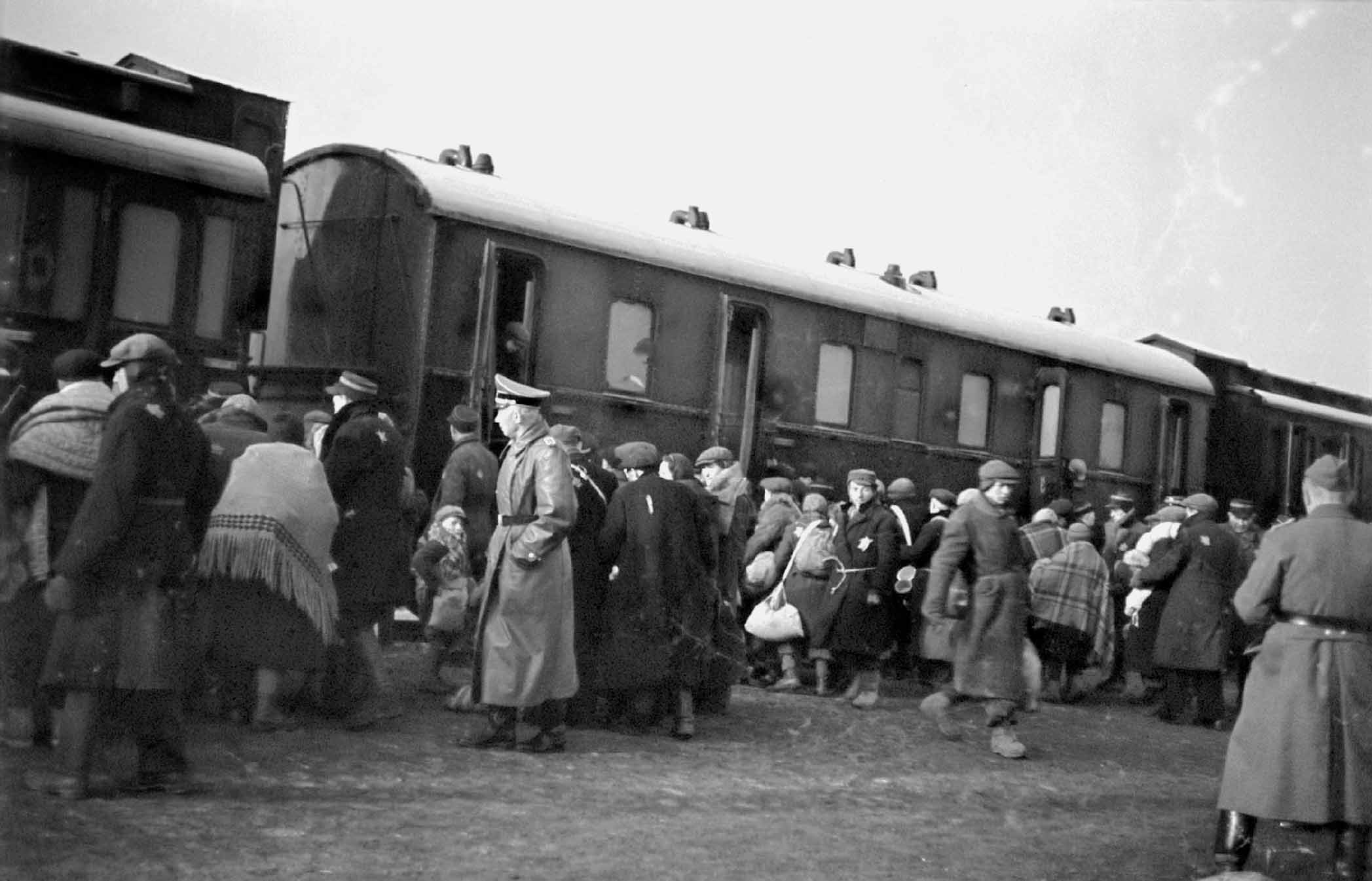
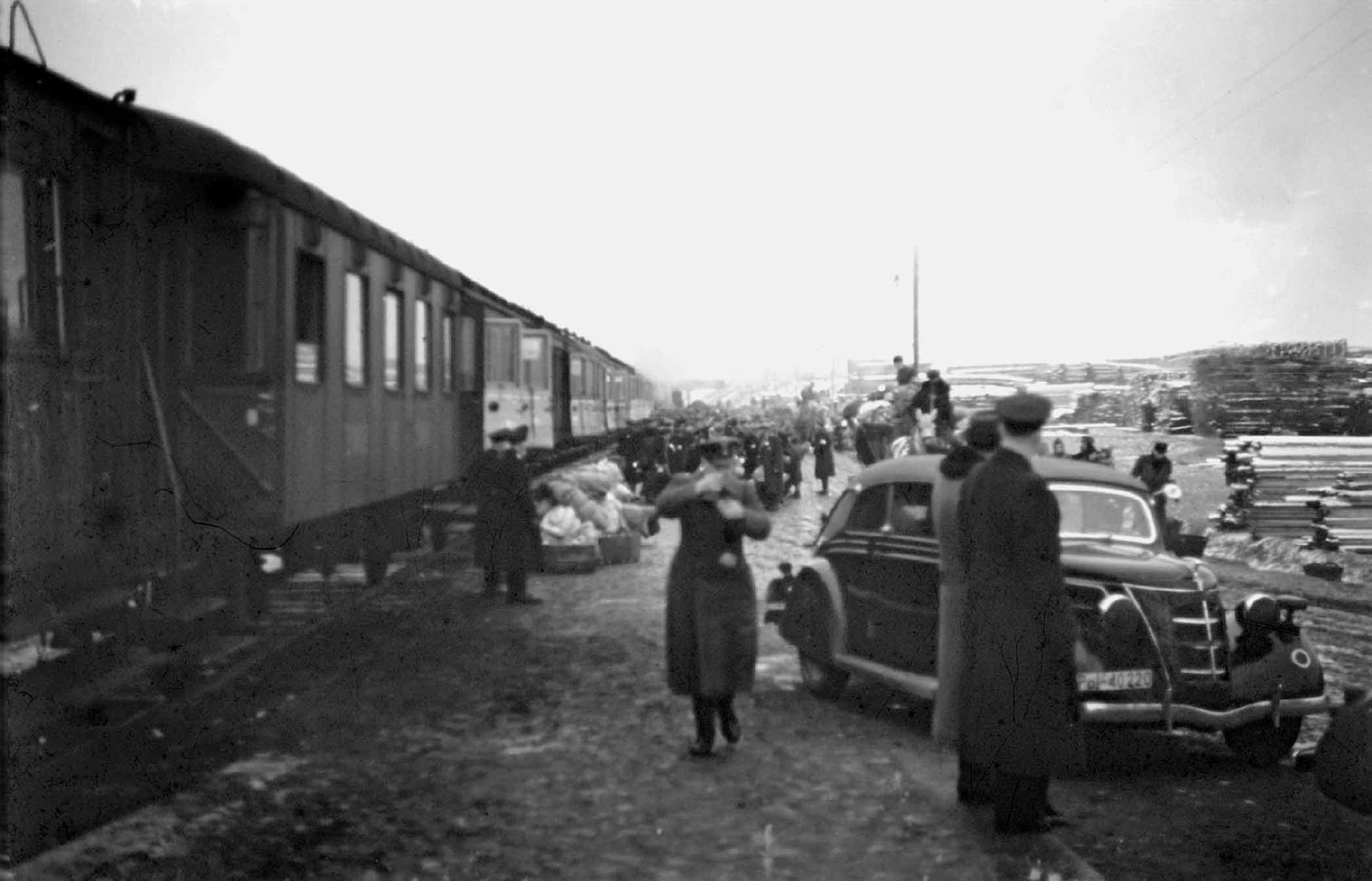
Four photographs showing Jews boarding a train during a deportation action in the Łódź ghetto. The original German caption reads: ‘Judenaussiedlung [resettlement of Jews], April 1942’. By this time some 34,000 Jews had been deported by rail like this and sent directly to the Chełmno death camp. Although the German authorities had told the Jews they would be resettled further east, it had already become common knowledge that the mass executions were taking place. Some parents fearing the inevitable committed collective suicide to avoid their children suffering at the hands of the Nazis. (USHMM: Robert Abrams)
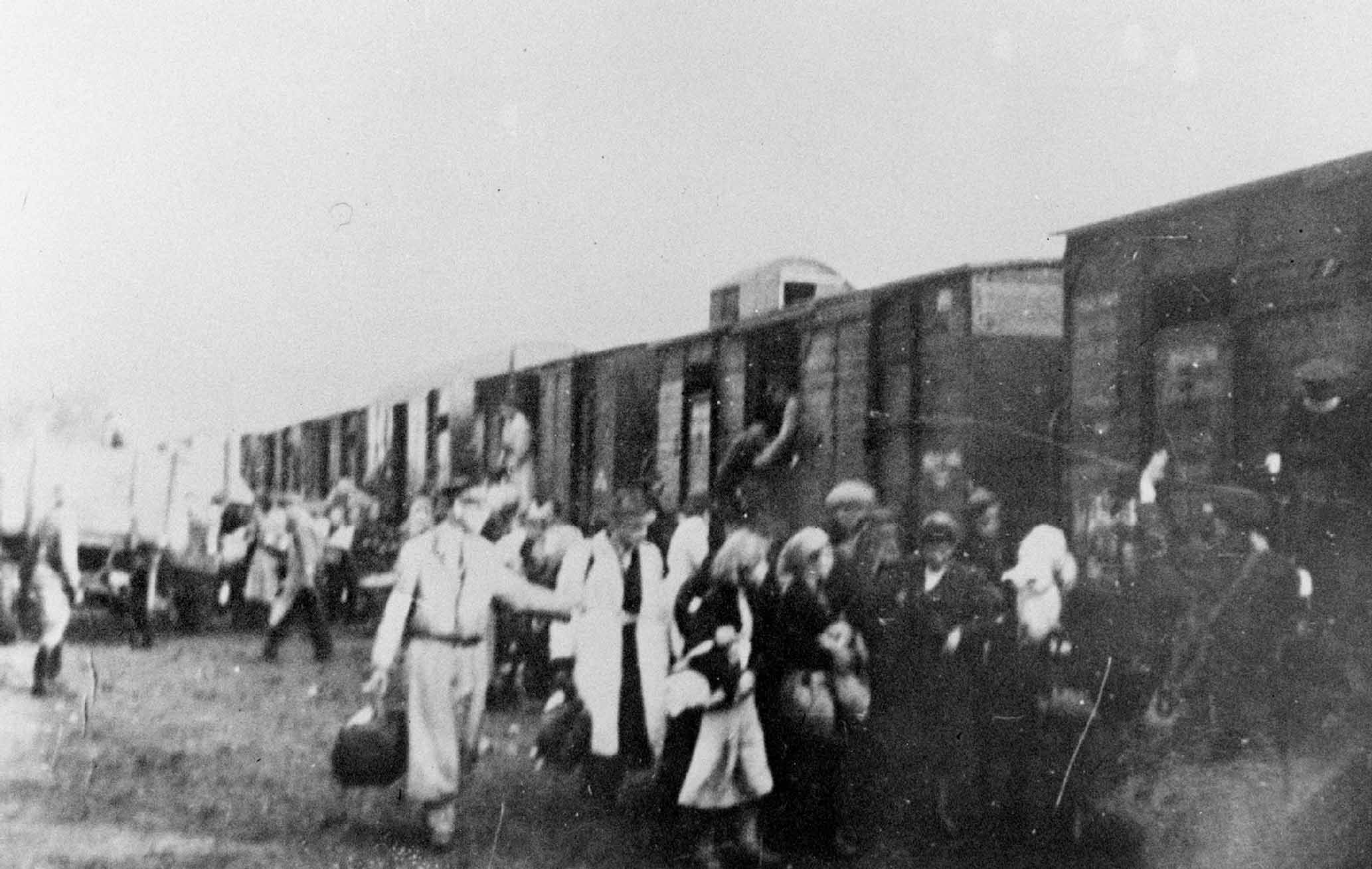
Jews from the Warsaw ghetto board a deportation train with the assistance of Jewish police. (USHMM: Instytut Pamieci Narodowej)